
Dates tested: 2/26/2014-3/05/2014
Miles driven: 408
Fuel used: 14.4 gallons
Real-world fuel economy: 28.3
Driving mix: 35% city/65% highway
Base price: $31,195 (not including $795 destination charge)
Options on test car: None
Price as tested: $31,990
Quick Hits
The great: Great handling, a blast to drive
The good: Impressive power, surprising fuel economy
The not so good: Class-typical cramped rear seating area
Rick Cotta
The Subaru Impreza – and by extension, our WRX tester on which it’s based – has long been one of my favorite compact cars, and not just because it comes with all-wheel drive – which I like very much indeed. But if it weren’t for the last item, I’d probably lean toward the Honda Civic as the best sedan in the class, mostly because it suffers virtually no discernible faults. The Impreza and WRX are also very good in this regard, but they’re not perfect. To wit:
- Typical Subaru (meaning great) visibility thanks to typical Subaru (meaning thin) roof pillars.
- Decent interior storage with large glovebox; big forward-console bin; small console box with Aux, USB, and 12-volt plugs; two console cupholders and a small tray; and small map pockets in the doors.
- Audio and climate controls are mounted high but just out of easy reach (I had to lift my shoulder from the seat back). Audio controls consist of small station-select buttons (Yes! Actual buttons!) and rotary volume and tuning knobs. Three rotary knobs control the climate system, though the effects of turning them appear on an upper dashboard screen.
- The dashboard and door tops are all swathed in padded material (though it’s rather hard), as are the armrests. Some carbon-fiber trim and bright accents help dress up the interior, which struck me as somewhat upscale as compact cars go.
- The image from the backup camera is displayed on a screen at the top of the dash, where it’s easy to see, but the screen itself is too small.
- Seating room is fine for four average-size adults, which is really all that should be expected from a compact sedan.
- The rear seat backs fold down to reveal a large pass-through opening, and they lie nearly flat and level with the cargo floor (which not nearly enough do). However, you may have to remove the headrests to get them to fold all the way flat.
Read about the 2014 Imprezza WRX
And then there are the qualities of the sporty, WRX version:
- The turbocharged engine produces lots of power, and it builds linearly, without the usual turbo surge.
- Out tester was equipped with the CVT automatic, and it didn’t suffer as much “rubber-band effect” as most; in fact, at first I didn’t realize it was a CVT. The only time the powertrain combination wasn’t entirely impressive was in full-throttle launches, as it took a moment for the power to hit. But when it did … oh boy. “Kickdowns” when nailing the throttle at speed were quick.
- And the beauty of all this is, the WRX really didn’t much care how slick the streets were. Granted, our tester was shod with winter tires, which undoubtedly helped, but grip would likely have been impressive even without them. I followed a Mustang GT one snowy morning that was all over the road, but the WRX would shoot through the slush like it was shot out of a cannon. Really felt bad about sprinting away from stops while others were left spinning their wheels … though not bad enough to not do it again … and again … and ….
- WRX is a performance car, and it rides like one: A little too stiffly for my tastes, at least on the potholed thoroughfares of my home sweet home of Chicago. It probably wouldn’t have seemed as bad virtually any place else.
- The flipside of that is sharp steering response and little body lean in fast turns. It all makes the WRX a joy to drive … until you hit one of those blasted potholes.
Granted, our loaded tester came to nearly 30 grand, which seems like a lot for a compact car. But this is no ordinary compact car. And that’s another reason I liked it so much.
Test Drive: Mitsubishi Lancer Evolution GSR
Tom Appel
The thing I never did while driving our test WRX was grouse about not having a manual shifter.
That said, I would certainly prefer to experience this car with an honest stick shift, but I didn’t miss it nearly as much as I expected to.
The truth is, this CVT works very well. There’s little lag down low, no expected CVT “rubber band” delay and/or any turbo lag.
In simplest terms, I just enjoyed driving this car. Mostly the steering caught my fancy. Turning the WRX requires real effort, but the reward is fine precision and excellent feedback. The brakes are likewise responsive, and feel strong enough to stop a well-loaded tractor-trailer.
I almost wish the engine made a little more noise than it does. The power is wonderful, but I am used to a little more grit with my Subaru torque.
Our test car was equipped with winter tires, and so equipped made short work of plowing through several inches of fresh snow. We can’t say how the WRX would perform without the winter rubber, but suggest that folks in the Snow Belt seriously consider buying a set of cold-weather tires just the same.
At $32,000 our test car isn’t cheap, but for a seriously fast, sharp-handling sports sedan with standard AWD, it is a pretty good value. Note that a base car with stick comes in around $27,000, which is seriously compelling pricing.
